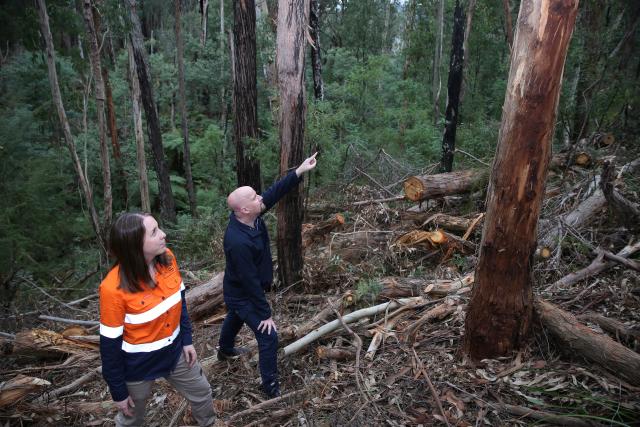
By Mikayla van Loon
The June 2021 storm event in the Yarra Ranges saw over 25,000 trees fall, having a significant impact on the livelihoods of hundreds of animals.
One of the main wildlife conservation areas in Mount Evelyn was heavily affected by this destruction of necessary habitat, seeing many trees that had been in the ground for 100, 200 and 300 years lose their footing.
Now a collaboration between Yarra Ranges Council and the Department of Environment, Land, Water and Planning (DELWP) will see fallen trees used to create natural habitats, as well as artificial nest boxes installed across six locations.
Biodiversity Rehabilitation Coordinator Scott Allen said because a decent sized hollow can take up to 200 years to form, replacing what was lost is important to ensure the survival of the 30 species in the Yarra Ranges that rely on hollows for nesting.
“We do have a number of different species that do depend on hollows for breeding and nesting and approximately 15 per cent of those are bird species and 31 per cent of those are mammals,” he said.
“Each species has its own requirements on size and location, so they can be a little bit fussy.”
These creatures range from the endangered Powerful Owl to the Yellow Bellied Glider and several small to medium owl species such as the Sooty Owl.
While other issues, like a change in soil composition and lighting conditions, have presented themselves because of the lack of larger canopy trees in forested areas, Mr Allen said in his initial assessments what struck him most was the reduction of important habitat.
“When I first started doing the assessment of these sites to figure out where my priority lies in terms of recovery, I knew that all the regeneration stuff would happen naturally and it would just be a matter of us controlling the weeds,” he said.
“But one thing that really stood out to me very early on was just the lack of trees. A lot of the trees are at a very similar age and height and therefore, we’re not going to get that diversity in terms of growth.
“A lot of these trees are at the age where they’re not old enough to be able to support hollow growth either.”
In an online seminar, held on Wednesday 15 June, explaining the artificial habitat hollows project, Mr Allen said he and his team had been considering the most effective way to construct the number of hollows needed.
Two options have been proposed: the first to use recycled plastic, modular nest boxes and the second, a hollow creation method using a customised chainsaw.
“The combination of these new nest boxes and new hollow creation method hopefully will allow us to rapidly roll out hollows where they’re needed quite quickly,” Mr Allen said.
“This will be not only good for the situation that we have at the moment where we have suffered a lot of impact but then we could also start rolling this out further down the line… [in] areas lacking hollows.”
Mr Allen said because timber can weather quite badly, research was conducted on the best solution to long term, sustainable nesting boxes that could regulate temperature and withstand the elements.
These nest boxes are ideal for smaller birds and mammals, while the chainsaw hollows can cater to the larger animals that usually require those 100 to 200 year old natural cavities.
“Our priority is habitat creation and tree health. So we need to make sure that what happens here with this hollow creation is that it’s going to last decades if not the lifespan of these trees.
“So the priority right from the get go has been to ensure that whatever we do is going to last a long time not just be something that’s implemented and needs replacement or maintenance within 10 years [because] we can’t risk losing any more trees than what we’ve already lost.”






